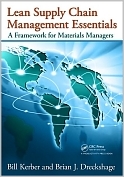net price + 5% vat.
Presenting an alternate approach to supply chain management, Lean Supply Chain
Management Essentials: A Framework for Materials Managers explains why the traditional
materials planning environment, typically embodied by an Enterprise Resource Planning
(ERP) system, is an ineffective support system for a company that wants to adopt Lean
practices. It begins by defining supply chain management basics, including roles,
objectives, and responsibilities from a traditional framework. Next, it describes Lean
basics and explores the conflicts between Lean and the traditional framework.
The book focuses on the materials management aspects of Lean, such as leveling
work into the value stream, heijunka scheduling, standard work, and the concept of
intervals, including Every Part Every Interval (EPEI). By combining traditional materials
management tools, such as Sales and Operations Planning (S&OP), with Lean
manufacturing approaches and applying them to different manufacturing environments, the
authors clarify the logic behind why you are doing what you’re doing with Lean
components and how they fit together as a system. Specifically, they explain how to:
- Determine which leveling strategy to use to smooth production
- Calculate interval to determine lot sizes in various production
environments
- Apply Lean to purchasing, warehouse, and logistics areas
- Use your value stream map for green initiatives and risk management
- Replace capacity planning and shop floor control with visual factory,
operator balance charts, EPEI, and plan for every part
Illustrating why balancing demand and capacity is better than trying to balance
supply and demand, the book includes a definitive chart that matches Lean tools to the
planning and control charts that have served as the model for ERP systems. It integrates
the principles learned from Toyota’s fifty-plus-year journey with Lean principles to
provide the up-to-date understanding required to approach the application of Lean to your
supply chain with a methodology that allows for experimentation, learning, and continuous
improvement.
Table of Contents
Lean Basics
Materials Management Traditional Planning and Control Framework Enterprise Resource
Planning (ERP)
Problems with ERP in Make-to-Order Environments Five Lean Principles Specify What Creates
Value from the Customer’s Perspective Identify All Steps across the Whole Value Stream
Make Those Actions That Create Value Flow Only Make What Is Pulled by the Customer Just
inTime Strive for Perfection by Continually Removing Successive Layers of Waste Lean
Focuses on Three Major Areas of Waste House of Toyota Framework Operational Stability Just
in Time Jidoka Goals Improvement and Respect Lean: Additional Considerations A Toyota
Leader’s View of the Toyota Production System Technical Management Philosophy/Basic
Thinking Planning and Control Hierarchy Lean Planning and Control Chart Leveling
Production Pull Systems Flow Interval as Lot Size
Executive S&OP, Forecasting, and Customer Relationships
Executive Sales and Operations Planning Role of Executive S&OP in Lean Lean
Manufacturing Executive S&OP What Is Executive S&OP?
Executive S&OP Focus Executive S&OP Process Product Families Aligning Families and
Resources Takt Time and Executive S&OP Forecasting Forecasting Perspective Forecasting
Basics Demand Patterns General Methods of Forecasting Forecasting as a Process An
Alternative to Forecasting: Supplier Partnerships
Leveling and Heijunka
Leveling Value Streams Mix and Volume Variability Definitions Buffer with Finished Goods
Inventory (a la TPS): Make to Stock Bill of Materials Shape Helps Dictate Strategy How
Lean Fits In: Make to Stock Leveling Production Mix vs. Sales Mix: Heijunka Scheduling
Buffer Demand Variability with Lead Time (Backlog): Make to Order Managing Backlog Chase
Hybrid How Lean Fits In: Postponement MPS and Heijunka Master Production Schedule
Concluding Observations
Dependent Demand Materials
Benefits of Creating Flow Batch Manufacturing Lean Process Flow Operator Balance Chart
Batch Flow One-Piece Flow First-In-First-Out Flow Typical FIFO Lane Rules Material
Planning Material Planning Horizons Mix Issues
Capacity Management and Shop Floor Control
Issues with Traditional Capacity Planning Capacity Planning in Lean Value Stream Loops
Capacity and Pull Standardized Work in Process Shop Floor Control Heijunka, Flow, and
Visual Control as Shop Floor Control Staffing and Takt Time Operator Balance Chart
Inventory Management
Traditional Inventory Management The Importance of Inventory Management: Customer
Satisfaction and Company Financials Concepts of Traditional Inventory Management Order
Quantity When to Order Lean Inventory Management Inventory as Waste Inventory Management
in Lean Visual Control Approaches to Reducing Inventories Supermarket Sizing as a Way to
Reduce Inventory Kanban Sizing WIP Inventory: FIFO Management Reducing Pipeline Inventory:
Kanban—Visual Card Inventory Reduction through Reducing Lot Sizes Point of Sale Data
Lot Sizing
Lot Sizing in Lean One Piece Every Part Every Interval (EPEI)
Why Should We Strive for Smaller Intervals?
So How Do We Determine the Interval?
An Example: Murphy’s Toys Trim Data Interval and Capacity Balancing Work (Operator
Balance Charts)
Lot Sizing as Part of Scheduling Applying the EPEI to Traditional Planning Systems: The
Period Order Quantity Mix Issues Volume Variability Mix Variability Making Sense of
High-Mix Value Streams What Do We Gain by Increasing the Interval?
Interval as Goal Setting High-Mix Interval Determining the Interval Interval in Value
Stream Loops
Warehousing and Logistics
Traditional Physical Control of Inventories Traditional Relationships
Packaging—Readying an Item for Shipment Overall Warehouse Setup and Item Locations
Traditional Logistics Logistics Skill Freight Cost Distribution Requirements Planning Lean
Warehousing Controlling Space Controlling Labor Lean Logistics Inbound Logistics Outbound
Logistics Zone Skipping Packaging Product Availability and Its Effect on Logistics
Collaboration Visibility and Reliability
Quality Control
Lean Quality Lean and Total Quality Management—Visual Control Poka-Yoke Methods and
Examples Lean and Quality Control—Jidoka/Autonomation Lean and Total Quality Control
Management—Companywide TS 16949
Seven Lean Quality Tools
Purchasing
Developing a Systems Perspective for Purchasing Traditional Purchasing Lean Purchasing
Keiretsu Lean Partnership Quality Supplier Quality Audits Cost Lean Purchasing and the
China Price Delivery Improving Delivery and Flexibility by Reducing Lead Times and Lot
Sizes Reducing Supplier Base Keeping Critical Items Internal Measuring Delivery
Performance Technological Capabilities Design and Development
Lean System
Summary and Conclusions
Appendices:
The Myth of the Bell -Shaped Curve: Inventory Level and Customer Service The Bullwhip
Effect Lean Implementation Methodology Using your Value Stream Map for Green Initiatives
and Risk Management
Index
274 pages, Paperback
Księgarnia nie działa. Nie odpowiadamy na pytania i nie realizujemy zamówien. Do odwolania !.


